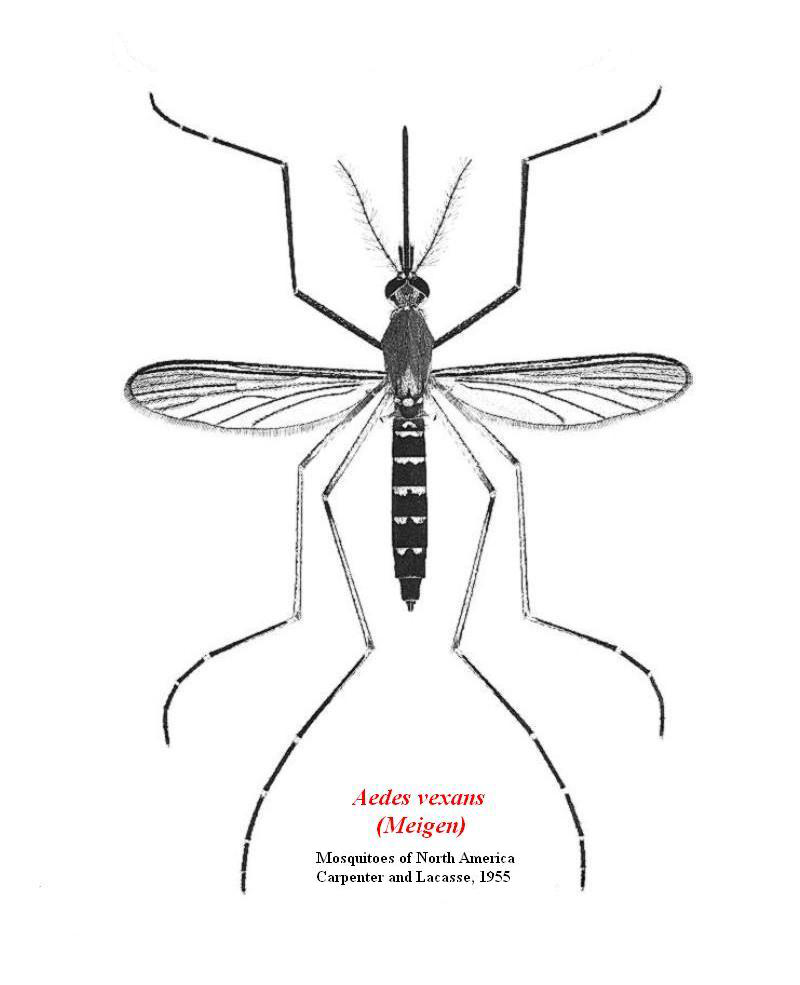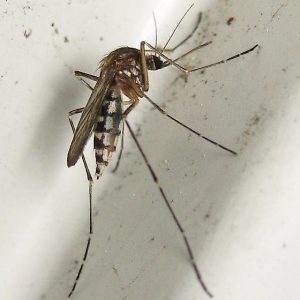Aedes Vexans
 Aedes vexans is also called the Inland Floodwater Mosquito. It is one of the most widespread and common types of mosquitoes in the world. The word “vexans” comes from the Latin word “vexāre” which means “to annoy” and considering that Aedes vexans is the most abundant species in North America and is found all over the world (except in Antarctica and South America), it lives up to its name. The adult Aedes vexans is black with narrow white bands on the base of each leg section, and the bottom of the abdomen has white-scaled bands that are sunken in the middle.
Aedes vexans is also called the Inland Floodwater Mosquito. It is one of the most widespread and common types of mosquitoes in the world. The word “vexans” comes from the Latin word “vexāre” which means “to annoy” and considering that Aedes vexans is the most abundant species in North America and is found all over the world (except in Antarctica and South America), it lives up to its name. The adult Aedes vexans is black with narrow white bands on the base of each leg section, and the bottom of the abdomen has white-scaled bands that are sunken in the middle.
Like other Aedes mosquitoes, Aedes vexans are floodwater mosquitoes. This means that after taking a blood meal, the females lay their eggs one at a time in low-lying areas that are above the water line that will eventually flood. The eggs then go through a period in which they dry out before they have the capability of hatching. These eggs need to be flooded and, in some cases, flooded twice before they hatch.
Unlike some mosquitoes, Aedes vexans do not hibernate during the winter as adults; instead, they overwinter in the egg stage. This means they survive throughout the winter season as an egg. In the egg stage, they go into a hibernation-like resting phase called diapause that allows them to survive unfavorable conditions such as extreme temperatures, drought, or food scarcity that they could not survive as adults.
These mosquitoes have evolved complex strategies for knowing when to end their diapause. For example, if flooded with water that is too cold, the Aedes vexans eggs will not hatch. When spring arrives, and temperatures begin to warm, and the rainwater fills low-level areas, the Aedes vexans eggs will hatch.
 Overwintering Aedes vexans eggs hatch in April and May. Adults will die off in late October/early November when the frosts come, but they will leave overwintering eggs in diapause to hatch and repeat the cycle in the upcoming Spring.
Overwintering Aedes vexans eggs hatch in April and May. Adults will die off in late October/early November when the frosts come, but they will leave overwintering eggs in diapause to hatch and repeat the cycle in the upcoming Spring.
This particular mosquito is multivoltine, meaning that it has two or more broods of offspring per year. Although adults have a short lifespan and usually die soon after mating, the quick development of the larvae helps the Aedes vexans populations grow exponentially throughout the mosquito season. Aedes vexans are aggressive night biters but are also known to feed during the day. They are spreaders of Rift Valley Fever, a disease only found in Africa. However, due to how widespread Aedes vexans is, there is concern that they could transmit this dangerous virus to other parts of the globe.
Most mosquitoes do not travel very far from their birthplace (1-2 miles), but an adult Aedes vexans will sometimes travel 15-20 miles in search of food, shade, or suitable places to lay her eggs. Like all mosquitoes, male Aedes vexans only feed on flower nectar and are pollinators. However, the females will take blood meals to get the proteins they need for egg production. Therefore, female feeding spreads disease.
